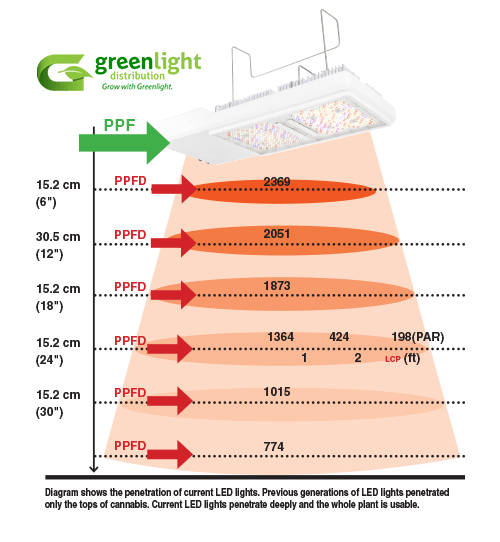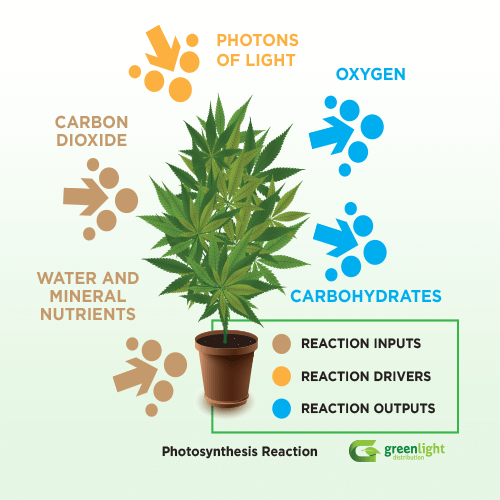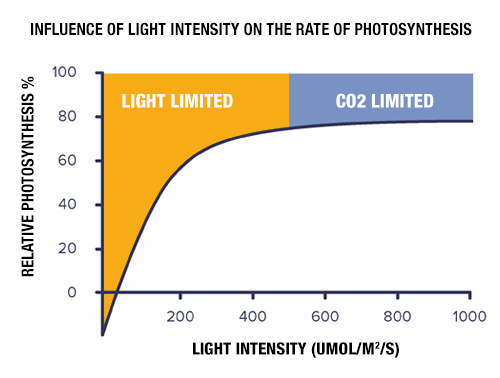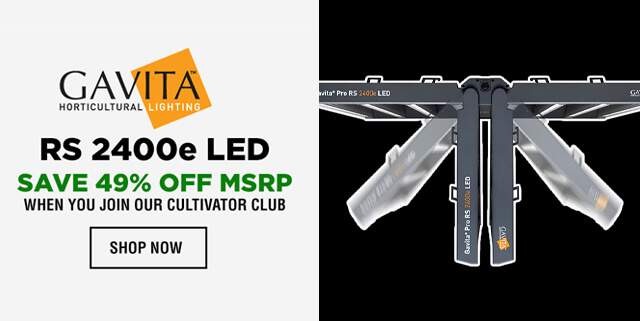
- Use less energy than traditional HPS lamps and therefore cost less to operate
- Reduce HVAC (air conditioning) costs by up to 50%
- Qualify for energy rebates
- Last much longer than HPS bulbs
- Are more pleasant to work under
- Are easy to install and move
- Provide more control of spectrum, dimming and scheduling
- Are more environmentally-friendly and typically more recyclable
- Have a high IP rating (waterproof and dustproof)
Selecting quality LED grow lights
Cultivators have a large selection of LED options, but high-quality LED fixtures from trusted brands deliver the best light, longevity and features. As LED grow lights age, their lumen output depreciates (especially with cheaply-made LEDs). A poorly-performing or aging LED delivers fewer photons to your cannabis. With substandard or old LED grow lights, you will witness:
- Dropping leaves
- Upward cupping leaves
- Stems and branches reaching toward the light source
- New growth that is smaller and paler
While cheaply-made LED fixtures lose effectiveness quickly, quality LED lamps should last at least 50,000 hours, or 12 to 15 years of normal growing cycles.
What cannabis cultivators should know about PPF and PPFD
PAR (Photosynthetically Active Radiation) defines the type of light (electromagnetic radiation) needed to support photosynthesis in plant life. Through photosynthesis, plants convert light energy into chemical energy, which is the food they use to grow and thrive.
Plants use roughly the same part of the spectrum that’s visible to the human eye, but the wavelengths we perceive to be the brightest are not the most efficient wavelengths for photosynthesis. Scientists define different types of light by their wavelengths. PAR is the part of the electromagnetic radiation spectrum that is useful to plants to activate photosynthesis.
When selecting a lighting system that triggers photosynthesis, three measurements are important:
- How much light the fixture produces
- How much of that light is available to the plants
- How much light the plant receives during the photoperiod
Cultivators aim to purchase LED lights with best horticultural efficacy, which measures the plants reception of the blue and red light on the PAR spectrum. Photosynthetic photon efficacy (PPE) should be above 2.1 µmol/J or better for indoor growing facilities that have 1000 ft2 or more of canopy. In greenhouses where both the sun and supplemental lighting are used, the PPE should be greater than 1.7 µmol/J in facilities with the same 1000 ft2 or more of canopy.
The industry standard for measuring grow light efficiency is micromole per joule (sometimes written as umol/j, μmol/j, umolj-1 or PPF/W). That means that for every joule of electrical energy (joule = watt * second) a certain number of photon micromoles are produced. The higher the number the better.
PPF, PPFD, DLI, and Moles
- PPF tells us how many photons of light are emitted by a light source each second.
- PPFD tells us how densely the fixture distributes
the light photons on a one meter square target (i.e. your plants and
algae) in one second. - DLI tells us how many photons were delivered to a one meter square target in a full photoperiod (i.e., a day).
Photosynthetic Photon Flux (PPF)
The first measurement is Photosynthetic Photon Flux (PPF). This measures the photosynthetically active photons emitted by a lighting system per second. This measurement is expressed in “micromoles per second”. Note that the PPF does not tell us how much of the measured light actually lands on the plants (see PPFD below). PPF is expressed by scientists and light engineers as: μmol/second.
PAR defines the type of light needed to support photosynthesis, while photosynthetic photon flux determines the amount of PAR that is created by a lighting system each second. It is one of the most important parameters indoor gardeners use to monitor their artificial lighting systems.
Plants depend on light in order to perform the crucial function of photosynthesis. Additionally, plants depend on particular wavelengths of light to make photosynthesis possible.
Plants primarily use wavelengths of light between 400 to 700 nanometers to achieve successful photosynthesis (considered red light and blue light). The light within this range is called photosynthetic active radiation. PPF represents the measurement of all the photons in this range.
Quantum sensors are the main tool used to measure the light intensity of plant lighting systems. Although PPF does not equate to how much of the measured light will actually fall onto the plants underneath a particular light, it is still an important measurement in knowing how efficient a lighting system is at creating PAR.
Additionally, knowing the PPF of a lighting system does not denote the quality of the spectrum of light that plants receive.

Photosynthetic Photon Flux Density (PPFD)
The second measurement is Photosynthetic Photon Flux Density (PPFD). This measures the light that actually arrives at the plant. “PPFD” measures “the number of photosynthetically active photons that fall on a given surface each second”. PPFD is a ‘spot’ measurement of a specific location on your plant canopy, and it is measured in micromoles per square meter per second. This measurement is expressed by scientists and light engineers as: μmol/m2/s.

Daily Light Integral (DLI)
The third measurement is Day Light Integral (DLI) which measures the total amount of light that is delivered to a plant every day. This is the plant’s daily dose of light DLI measures the number of “moles” of photons per square meter per day and is expressed as: mol/m2/d. DLI is the most important metric for determining the overall growth rate of plants. Once you know the preferred DLI of your plants, you can easily set up a lighting system to deliver the required amount of light. Properly designed photosynthetic lighting systems start with defining the required DLI.
Moles
There are huge numbers of photons or “light particles” in visible light. We cannot express it using normal numbers, so we use two measurements used by scientists when measuring huge quantities. The first number — a Mole — is equal to something called “Avogadro’s number”, which is 602,214,150,000,000,000,000,000. A micromole is a millionth of a mole. A micromole of photons is 602 quadrillion. Since these numbers are so large, it is easier to reference quantities of light in moles and micromoles.
Light Intensity
Photosynthesis occurs inside of specialized organelles known as chloroplasts, and is the process that uses light energy to split water (H2O) and fix carbon dioxide (CO2) to produce carbohydrates (CH2O) and oxygen (O2). See the diagram for a simple representation of photosynthesis.

As light intensity (PPFD) increases, photosynthetic rates also increase until a saturation point is reached. Every plant species has a light saturation point where photosynthetic levels plateau. Light saturation normally occurs when some other factor (normally CO2) is limited.

During establishment growth, light intensities need to be kept relatively low as the cannabis plant is developing leaves and stems that will be used to provide photosynthates during the vegetative growth phase. Increasing light intensity as you transition into the vegetative and reproductive growth phases will increase the rate of photosynthesis, which will provide the plant with more photosynthates used to develop flower.
Plants need time to acclimate to high light intensities (referred to as photoacclimation). If you expose plants to high light intensities too early in the crop cycle, you can damage chlorophyll pigments causing photo-oxidation (photo-bleaching), so we recommend slowly increasing your light intensity as your cannabis plant develops.
Contact Greenlight for more information about LED lights and how to optimize your grow rooms.
About Greenlight Distribution
Greenlight Distribution provides best in class growing equipment at low prices for commercial cannabis cultivation. As a total growth partner, Greenlight sells more than 6,000 growing products, provides personalized consultation and design services, and delivers innovative financing solutions. As a direct lender to the industry, Greenlight provides debt capital to finance large purchases, manage cash flow, expand operations, and grow your cultivation business.
